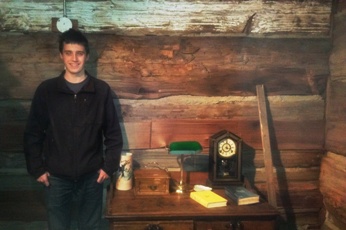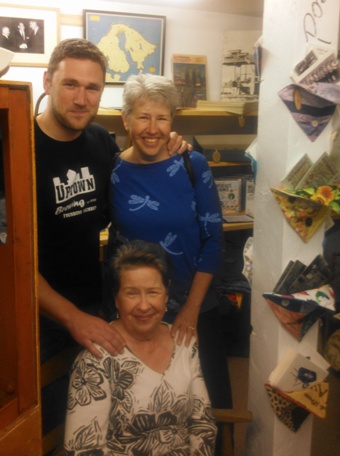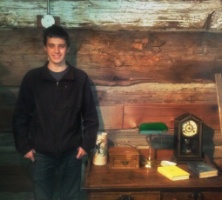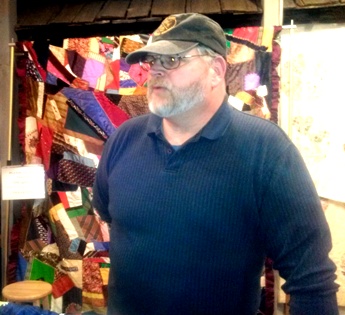— by Margie Doyle —

Eric Eagan at the Orcas Historical Museum, in the small log cabin he transformed into a representative island resort cabin
The Orcas Historical Museum is now open for the summer season! Recently board and volunteers celebrated its new gift shop, a refurbished “resort” cabin, an island quilt exhibit and plans for a Flotsam and Jetsam exhibit and a good old-fashioned “Mortgage Burning” party.
Director Clark McAbee proudly displayed the work of Orcas High School Senior Eric Eagan, who transformed the “Resort Cabin” in the center of the museum. In fulfillment of his Senior Project, Eric has set the room to look as a typical, one-room cabin in the heyday of Orcas’ resort era, when multiple rustic resorts dotted the island from Deer Harbor to Doe Bay.
Volunteer Judy Turksel, with her daughter Marta Branch and grandson Tyson Bernhardt in tow, showed the renovated gift shop. Island artist and Museum volunteer Carla Stanley masterminded the former “vault” room into a Museum Gift Shop where visitors can purchase mementos and artifacts of Orcas Island history.

Three generations of Orcas Islanders in the Museum’s refurbished gift shop: Tyson Berhardt, Marta Branch, and Judy Turksel
The “Island Quilt — Preserving Our Communities” exhibit, displays the handiwork and artistry of Orcas Island quilters. Of particular note are the hand-embroidered velvet patchwork pieces which island pioneer Jane Barfoot-Hodde created in her 90s. The Quilt Exhibit extends into the entry corridor which is named in her honor.
Looking into the near future, McAbee announced that once again, the Museum will bring the Harvey Family Logging Show to its July 4 celebration. Also planned are games, a beer garden, a live auction, homemade pies, free tours of the museum’s six cabins, fair vendors and “endless family fun.”
McAbee, who commutes via his motorcycle from La Conner to Orcas Island, relishes the prospect of the “Flotsam and Jetsam” exhibit. The “How on Earth did this Come to Orcas?” question will be explored when the Quilt Exhibit closes on July 11. Quirky, random and historic items that have arrived on Orcas over the last two centuries will be displayed. McAbee writes on the Museum website: “Working in the museum archives cataloging the photos and artifacts gathered during the organization’s sixty plus years of existence … I am often struck both by the variety and oddity of some of these objects.”
Once again, this fall the Museum benefit “Cruise into History,” sponsored by Orcas Island Eclipse Charters, will raise funds for the non-profit Historical Society.
And ongoing is the “Burn the Mortgage” campaign to pay off the balance from the 2006 building project loan. That balance is $40,000, and half of that amount has been obtained in pledges. With islanders’ support, our Historical Museum can get this done and have a mortgage burning party in 2014!
To contribute, send tax-deductible donations to OIHM, PO Box 134, Eastsound WA 98245; or donate online at www.orcasmuseum.org .
Other plans including building a new equipment shed, with a fund established by the Englehartson family; and building a foundation for the fire barn and restoring it.
The Museum on North Beach Road is open from Wednesday through Saturday, 11 a.m. to 4 p.m. and on Sunday from noon to 3 p.m.
Want to be part of Island Life — past, present and future? Come to the Museum Weds-Sat from 11 a.m. to 4 p.m. and Sunday noon to 3 p.m.; visit the website, or call the Museum at 376-4849. Museum Board meetings take place the third Wednesday of every month and are open to the public. Director McAbee says, “Feel free to stop by if you would like to learn more about the workings of the museum.”
The Orcas Island Historical Society’s first museum consisted of artifacts displayed on the front porch of a pioneer family’s home. Property for a permanent museum site was eventually obtained in the village of Eastsound, a location the pioneer museum, and offices continue to occupy today. In the 1950s and 1960s, various island families donated six original homestead cabins [built] during the 1870s and 1890s to the Society. Volunteers disassembled the structures at their original sites, then moved, reconstructed and linked the structures together to create the main museum facility. These cabins are now all over a hundred years old, and not only house the collections, but are considered important historical artifacts themselves. Each cabin serves as a space for interpreting specific aspects of island history as told through the life stories and material culture of the Native American and early European-American settlers of the area. The Orcas Island Historical Museum is unique in being the only object based, interpretive heritage facility for the island, with permanent collection comprised of approximately 6000 objects, paper documents photographs. (from www.orcasmuseum.org )
**If you are reading theOrcasonian for free, thank your fellow islanders. If you would like to support theOrcasonian CLICK HERE to set your modestly-priced, voluntary subscription. Otherwise, no worries; we’re happy to share with you.**









